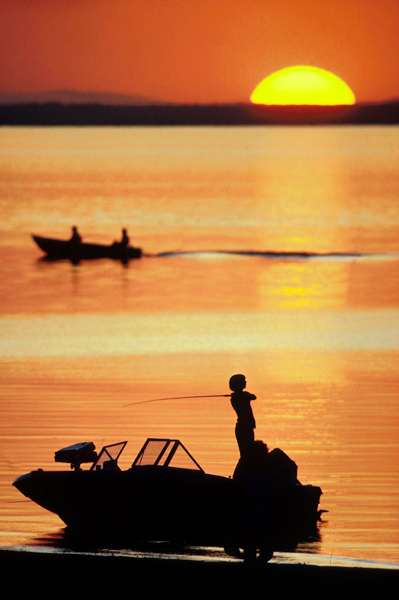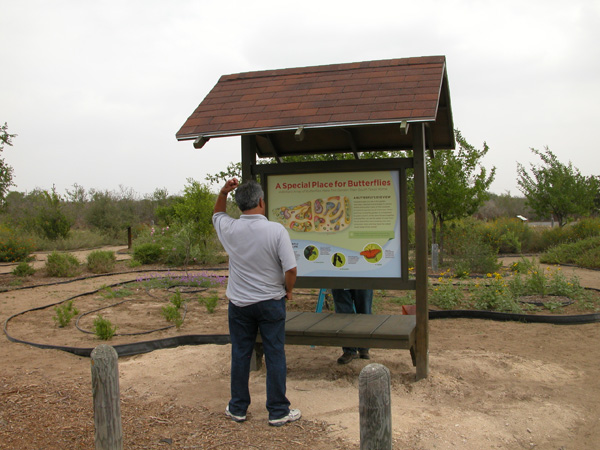Looking for a Quick Getaway?

Destination: Falcon Lake
By Dyanne Fry Cortez
Travel time from:
Austin - 5.25 hour /
Brownsville - 2 hours /
Dallas - 8.5 hours /
El Paso - 13 hours /
Houston - 6 hours /
San Antonio - 4 hours /
Lubbock - 10.5 hours
Swarms of butterflies, excellent Mexican food and good fishing make this South Texas spot worth the drive.
For years, my husband has shared tales of childhood adventures at Falcon Lake. His family would bring a boat from Kerrville, stuffed to the gunwales with ice chests, cots and fishing gear. Rio Grande Valley relatives would meet them at Falcon State Park. They'd spend two weeks camping, cooking out and looking west toward Mexico as the sun set over the lake.
Day One
They say you can't go home again, but maybe it's possible to revisit an old vacation spot. We leave Austin at sunrise and reach the park entrance shortly after 1 p.m.
Falcon State Park opened in 1965 on the southeast shore of International Falcon Reservoir. The lake has been through some changes since Javier last fished there. His family used to catch boatloads of white bass and crappie. Those populations dwindled during a drought that began in the mid-1990s and lasted nearly a decade. The lake was 45 feet low at one point in 2003, "and most of the lake is nowhere near that deep. It was basically down to the river channel," says Bobby Farquhar, regional director for Texas Parks and Wildlife's Inland Fisheries Division.
Some thought the lake would never fill again, but it did. Rising water flooded acres of vegetation that had grown up during the drought, providing the kind of cover that produces big largemouth bass. Catfishing is good, too, Farquhar says.
Screen shelter #10, our home for the next two nights, is set back from the road in a thicket of Texas ebony, wild persimmon, cenizo and blue-berried coyotillo. It hasn't changed much since the 1970s. In fact, Javier is pretty sure this is exactly the shelter where his family used to stay. Inside, we find a picnic table, ceiling fan and room for all our gear. Unseen birds twitter in the brush, perhaps warning their neighbors that a couple of humans have arrived.
The park has 12 shelters like this one. Twelve more across the road have been converted to air-conditioned cabins. Other camping areas offer no-frills tent spots and RV sites with full and partial hookups. There are blinds for birdwatchers and a three-mile nature trail. What I really want to see, however, is the park's new butterfly habitat.
It's alive with color and motion. Orange-winged queens and soldiers light on blue mistflowers. Yellow sulphurs flutter through red sage. "Each bed is color-coordinated, because that's the way butterflies like it. You need masses of color," says park interpreter Fran Bartle, who designed the garden. Every plant growing there is native to Starr or Zapata County. Nectar plants provide food for adults, but it's also important to include host plants for caterpillars.
Bartle is a volunteer spending her fifth winter at Falcon. She leads a bird walk three times a week. When Park Manager Damon Reeves brought up the idea of a butterfly habitat, she took it and ran with it. "I've been in an RV for six years. The only thing I missed was having a garden," she says.
Ebony and wild olive trees were already growing in the space. The rest of the plants went in last March. Bartle thought it would take several years to see results, but the summer of 2007 was an unusually wet one. When she returned in fall, the plants were thriving and the butterflies were there. Park observers counted 125 species between October 1 and mid-November. Park observers counted 133 species between October 1 and late December. The tally included a rare telea hairstreak, which hadn't been recorded in the United States for more than 70 years.
Ron and Candy Wicker run a seasonal concession in the park's Recreation Hall, and they've invited us to dinner tonight. The Wickers have been coming here for 34 years. They head the nonprofit friends group, the Oilfield Park Endowment Charity. In the past 14 years, the group has helped finance the butterfly garden, shelter renovations and improvements at the boat ramp. Its big fundraiser is the OPEC Legacy Bass Tournament, held every October. Souvenir sales at the Rec Hall generate some additional income. The Wickers keep it open as a restaurant, store and activity center during the winter months.

The park attracts distinct types of visitors. Winter Texans start arriving in November and move on by the end of March. Area residents think of Falcon as a neighborhood park. They may visit any time, but Easter weekend is especially busy. Anglers come from far and wide to fish the lake, and youth groups come in the summer.
A stiff breeze blows our hair as we walk back to our shelter. Sleeping will be good tonight. "This is the weather of my youth!" says Javier. We play a few hands of cards, then take our chairs outside for some stargazing before turning in.
Day Two
Falcon Lake was impounded in 1954. In this part of Texas, that's a recent development. Jose de Escandon brought colonists here in the 1740s. Descendants of some land-grant families still live in the area. The city of Roma was founded in 1768, when Texas was part of Mexico and Mexico was still a colony of Spain.
Roma is about 15 miles southeast of the park on a high bluff overlooking the Rio Grande. We park our truck on the Main Plaza, featured in the 1950s movie Viva Zapata!, and walk through the downtown historic district. Roma contains more than 30 structures built before 1900. Many were designed by German brick maker and architect Heinrich Port-scheller. At the south end of downtown, just beyond the international bridge, we see the towers of the 1928 suspension bridge that carried border traffic for several decades. At one time, there were four bridges like this across the Rio Grande. This is the only one that survives.
Leaving the historic zone, we find lunch at El Mexicano Restaurant. It's a homey kind of place with large sunny windows and yellow oilcloth on the tables. There's an extensive menu, all in Spanish, offering the usual Tex-Mex fare along with six kinds of soup, kids' selections and family platters. We order fajitas for two. The waiter arrives with a spread that would feed a Scout troop: handmade tortillas, beans, rice, gooey nachos, lettuce, tomatoes, guacamole, and a heap of real skirt steak, nicely grilled. Regretfully, we couldn't finish it all.
The village of Falcon Heights, just outside the park, is quiet today. "We don't get as many visitors as we used to," says Mike Garza, proprietor of the 83 Motel & Grocery. Garza is 70 years old, "...going on 50," and has run this place for 22 years. He sells snacks, drinks, fishing lures and worms, hardware, school supplies, and albums by South Texas musicians. One of his sons is lead ranger at the state park. A granddaughter works in the park office.
Back at camp, we rendezvous with friends and co-workers from Austin who have just arrived with a fishing boat. John, Elizabeth and Bryan are visiting Falcon Lake for the first time.
Day Three
We launch the boat at 9 a.m. With five people aboard, John feels it's too crowded for safe bass casting, so we try for catfish. We steer downstream into the shadow of the dam, which blocks some of the wind blowing in from the coast.
We stay out a couple of hours, fishing in three different spots with no success. Javier is out of practice and I'm not much of an angler, but our friends are, and they aren't catching anything either. Bryan switches to bass lures. He lands one just as we're about to head for the dock. Not a keeper, but at least it's a fish.
Three anglers ahead of us at the boat ramp appear to have had better luck. We follow them to the cleaning station and watch them clean four good-sized bass, one weighing four pounds. They say they came with friends from the McAllen Bass Anglers' club, who are fishing in a weekend tournament.
"You should've been in the tournament," Elizabeth says, eyeing the fish in their cooler.
"If we were, we wouldn't be doing this," one of the men replies. "They're catch-and-release. We're catch-and-eat."
The tournament anglers report for weigh-in at 2 p.m., and most complain about the weather. "That wind was awful," says club secretary Al Malone. "We had some spots picked out, but we just couldn't get to 'em." Still, I see that everybody has at least two or three fish to weigh in.
Falcon Lake attracts quite a few bass tournaments nowadays. Bass Champs South had a team event here in March 2007 and plans another this year. The FLW Outdoors Stren Series held here in January set new total cumulative weight records over four days (110 pounds, 2 ounces), and the Bassmasters Elite Series will visit Falcon for the first time April 3-7, 2008.
"They've discovered this lake," Malone says, cheering up a bit as he considers the big picture. "It's really the best in Texas, I think."
Border Issues
For Texas travelers, a trip to the Rio Grande Valley often includes a foray into Mexico. The International Bridge between Roma and Ciudad Miguel Aleman is open 24 hours. A drive across Falcon Dam takes you to the village of Nuevo Guerrero. Gates on the dam are open 7 a.m. to 8:45 p.m.
Border crossings are more complicated than they used to be. As of January 31, U.S. and Canadian citizens coming into the United States from Mexico must show a passport or a government-issued photo ID along with proof of citizenship, such as a birth or naturalization certificate. Children under 19 don't need the photo ID, but they do need proof of citizenship. The government will eventually require a passport for anyone entering or leaving the U.S., perhaps as early as summer 2008. Some type of alternative document may be available; details were still being discussed at press time. For updates, visit the Customs & Border Patrol Web site (www.cbp.gov/) and select the "Travel" link.
On Falcon Lake, the international border is marked with buoys. Fishing in Mexican waters requires a Mexico license for everyone in the boat, whether fishing or not. As of January 2008, Mexico boat permits are no longer required.
Pleasure boaters aren't considered to have "left" the United States so long as they stay on the water. If a boater sets foot on Mexican land, the return trip is technically a re-entry, requiring a phone call to the Border Patrol. Many people are unaware of this rule, but with increased border security, it may be an issue in the future.
Details:
- Falcon State Park (956) 848-5327)
- Falcon Heights Motel & RV Park (956) 848-5229
- 83 Motel & Grocery (956) 848-5223
- El Mexicano Restaurant (956) 849-4275
- Customs & Border Patrol (956) 849-1678
- Roma Historical Museum (956) 849-1411, corner of Lincoln and Portscheller streets, open Monday-Friday by appointment. Inquire at Roma City Hall on the Main Plaza.
- World Birding Center, Roma Bluffs (956) 849-4930
- Mexico fishing licenses: Falcon Lake Tackle (956) 765-4866 <www.tackleandrods.com>
This article appeared in the April 2008 issue of Texas Parks & Wildlife. If you’d like to read more articles like this or subscribe to the magazine, visit www.tpwmagazine.com/.
 Texas Parks and Wildlife Department, 4200 Smith School Road, Austin, TX 78744
Texas Parks and Wildlife Department, 4200 Smith School Road, Austin, TX 78744


